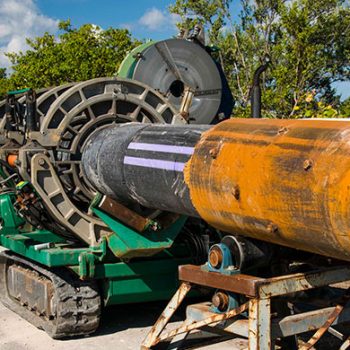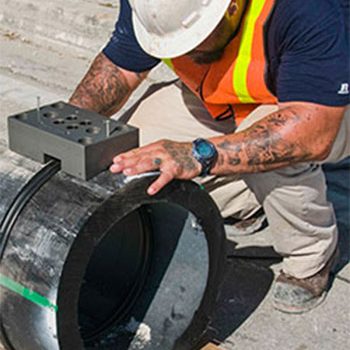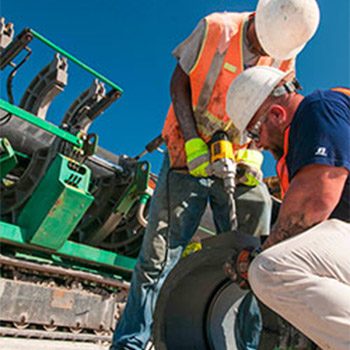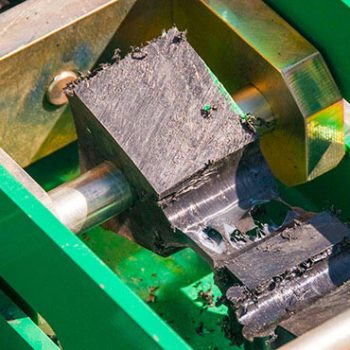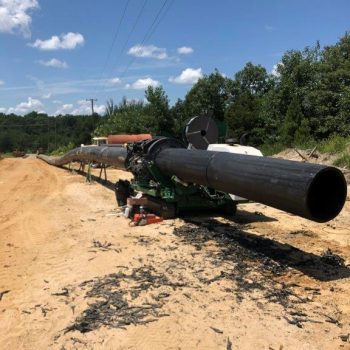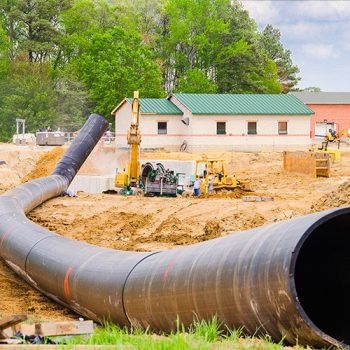North Bay Village, Florida is a small community near Miami that resides entirely on islands between the mainland and the barrier islands that are home to some of the world’s most famous beaches. The picturesque environment that draws tourists and celebrities by the boatload was under siege from an old cast iron sewer main that threatened to create environmental and health risks.
The threat made the community take action by launching a 14,115-foot design-build pipeline project that began in September of 2010.
“The present wastewater flows east from North Bay Village through the existing 12-inch force main transports wastewater from the City of North Bay Village to Miami Beach’s wastewater system, which is then re-pumped to Miami-Dade Water and Sewer Department’s Central District Wastewater Treatment Plant,” explains Ricardo Vieira, project coordinator for civil engineering firm Lockwood, Andrews and Newnam. “After project completion, the flow will be west from the City of North Bay Village’s Main Pump Station along the 79th Street Causeway west through the City of Miami and connecting directly to a Miami-Dade County Water and Sewer Department 24-inch force main located at 80th street and 7th Avenue.”
The City of North Bay Village awarded the design-build project to the team of underground contractor Metro Equipment Services; Lockwood, Andrews and Newnam, Inc.; and directional drilling subcontractor Arrow Directional Boring, Inc.
Arrow Directional’s co-owner Jeff Blake and his team were presented with unique challenges by the project, which required three sub-aqueous bores of 2,722, 1,352 and 1,306 feet.
The first of the bores connected North Bay Village’s Treasure Island to Harbor Island. The second bore connected Harbor Island to the 79th Street Causeway, with the final bore connecting Pelican Island to the City of Miami. To ensure the fusion operations of the project were perfect, Blake turned to a new cost-effective quality assurance tool, the In Field® Tensile Tester, from his preferred fusion machine manufacturer, McElroy.
Design-Build and Project Challenges
The design-build delivery method has inherent advantages and disadvantages for Arrow Directional and other contractors. Design-build projects consist of a construction team that takes on full responsibility for the design and construction for a project. These project types are growing in regularity because the owner of the project enjoys a single point of contact, cost savings, time savings and reduced administrative burdens.
“Design-build projects make it easier on municipalities because the main contractor is ultimately responsible for the entire project,” said Sam Zamacona Jr., public works director for the North Bay Village. “It also keeps change orders much more controlled.”
If everything runs smoothly, a design-build team can often enjoy higher profit margins than other construction types. If the project suffers significant issues, the risk and responsibility is on the team.
When you’re doing a nearly 2,700 foot bore, you just want to make sure that your machine and operators are working properly
One of the first challenges was getting two cities, one county, the health department, Department of Environmental Protection, Army Corps and South Florida Water Management District among many others agencies, to provide permitting in a timely manner.
“Our main delay was receiving permitting from the City of Miami and Miami-Dade County,” said Blake. “We were granted a 6-month extension on the project because the permitting issues were out of the contractors’ hands. Our hands were tied, but it worked out though. We have a professional team on this job.”
The job, originally slated for January 2010, was pushed back to September 2010 due to the permitting delays.
Butt Fusion and Directional Drilling
Once Arrow Directional mobilized and set up on site, the team used a McElroy TracStar® 900 to butt fuse the JM Eagle 20-inch IPS SDR 9 high-density polyethylene (HDPE) pipe. Approximately 5,500 feet of HDPE was used for the directional drilling, while the rest of the project called for PVC to be installed through open-cut methods.
The pipe fusion process performed by the TracStar 900 joins two pieces of HDPE with heat and pressure. The process begins by “facing” or shaving the pipe ends simultaneously so they can be joined together with heat to create a continuous, sealed pipeline. The welding of pipe segments is accomplished by using a Teflon-coated heater plate in contact with the pipe ends, which heats the polyethylene to a molten state. Then, after removing the heater plate, the ends are pressed together under a controlled pressure to form a weld and then cool. The resulting joint is as strong as or stronger than the pipe itself. Third-party research indicates that HDPE pipe and joints can have a lifespan of more than 100 years.
Blake turned to a new quality assurance device from McElroy to ensure that the pipe fusion procedure and fusion machine were working in unison daily.
“When you’re doing a nearly 2,700 foot bore, you just want to make sure that your machine and operators are working properly,” said Blake.
The McElroy In Field Tensile Tester is a testing device that provides a way to qualitatively test fusion joints in the field. Arrow Directional would begin each day of work by testing their first fusion joint in the morning.
The In Field Tensile Tester process begins by creating a coupon from a template that is attached to the pipe’s outer wall. Once affixed to the outer wall with screws, a drill and reciprocating saw are employed to make and connect a series of dots in a predetermined order to produce the coupon. The dual-reduced section coupon is then taken to the hand-pump-powered testing unit for a pass or fail assessment of the fusion joint. The reduced sections of the coupon offer a way of testing the recently created fusion joint versus the native pipe material. If the fusion joint pulls apart, the joint is faulty and troubleshooting of the problem begins. If the coupon pulls apart in the pipe wall, the joint is strong and fusion operations have been performed correctly. After getting the verdict from the machine, Arrow Directional continues on their day’s fusion work.
Although Blake and his team appreciate the peace of mind from the testing device, the rest of the design-build team appreciate Blake’s dedication to doing the job right.
“We think it is great that a contractor or subcontractor invests in quality tools,” said Vieira. “As engineers, we would recommend the use of such subcontractors over others.”
Blake turned to an American Augers DD-210 with 210,000 lbs of thrust and pullback for the drilling. Also used on site was a Tulsa Rig Iron MCS-500 designed to recycle drilling fluids and lower disposal costs. The MCS-500 helped Arrow recycle bentonite on site and was used with their down-hole mud motors.
Second Bore
While the first bore of the project went by without a hitch, the second of the three sub-aqueous bores started to present directional drilling design-build challenges for Arrow Directional.
Blake called Florida’s Sunshine State On-Call program, a state-mandated locating system for utilities to locate their property and infrastructure. Florida Power and Light arrived on the scene, presenting a bore profile that was a mirror image to the one Blake designed for the second bore. Because of a grouping of six-inch conduits that had been previously installed, the bore had to push deeper than the 44-foot depth previously designated for the line. At 47 feet, Arrow encountered a great formation of limestone.
“We couldn’t stay in the rock, just below Florida Power and Light’s previous bore, because that was the bottom of the rock layer, and then it was just sand,” said Blake.
Final Bore
The final bore that connected to the City of Miami’s sewer utilities was always going to be the trickiest of the three. Double the size of the previous two, the third bore featured a compound bend and only a 20-foot easement in which to keep the bore. Of the 2,722 feet, nearly 2,400 feet was in the waterway. Arrow began the final bore during the first week of January 2011 and finished the pilot bore in the third week of the month.
While the bore was arduous, creating the pipeline to be installed required special consideration to home owners within the City of Miami. A prerequisite required Arrow to build the pipeline after finishing the reaming of the hole, because the pipeline was to be staged down the middle of a residential roadway and the residents did not want to be inconvenienced.
Completion
The North Bay Village sewer force main now serves the community of 7,137. Despite the risks and challenges, Arrow Directional continues to seek out construction projects, including design-build projects. The North Bay Village project was the third design-build project of 2010 for the firm. Blake plans to use the In Field Tensile Tester to ensure the pipe fusion process is performed perfectly now and in the future.
